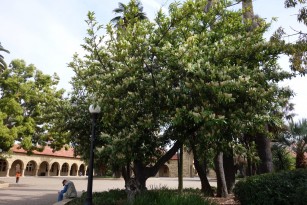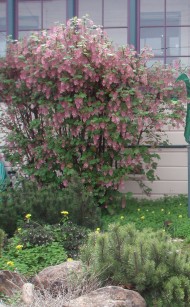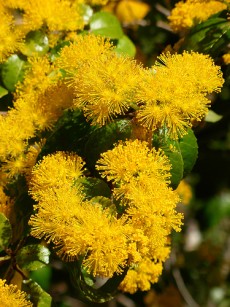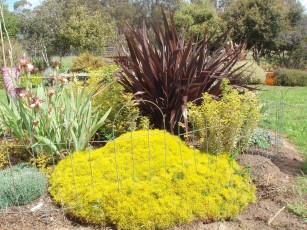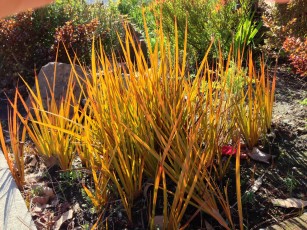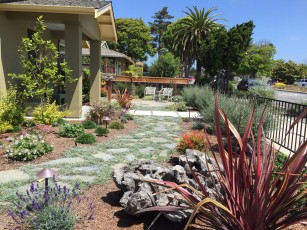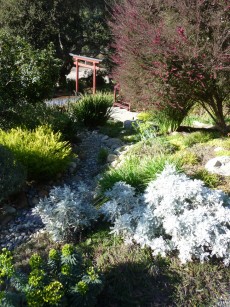
With so many people replacing their thirsty lawns with low water-use plants, I?m getting lots of requests for ideas about what to do with all that empty space. The sky?s the limit when you have a blank slate. Let me get you started.
If your old lawn was in the front you might consider putting in a sitting area for a couple of chairs and a bistro table. Use simple crushed gravel or more formal flagstone underfoot and surround the space with a low seat wall to add a bit of privacy.
Adding a dry river bed is another good solution. A dry river bed can slow runoff, spread it out and sink it back into the soil. Connected to a downspout they keep even more rainfall on your own property. If we get the El Nino storms that are predicted this will be a welcome addition to your landscape.
A dry river bed is a rock-lined swale that uses rounded river rock in addition to vegetation to allow
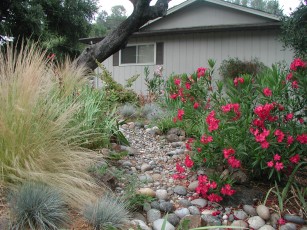
runoff to soak into the ground. Make sure there is a 2% slope from beginning to end to ensure that water is conveyed away from your house to the desired location. Non-woven geotextile fabric is often used underneath the rock.
You can create a depression or rain garden at the end of your dry river bed and plant it with plants that tolerate wet feet in the winter. Both a dry river bed and a rain garden allow water to sink back into the ground. The plants remove pollutants from the runoff from roofs or other impervious surfaces.
A rain garden might be a simple, shallow depression filled with plants that can flourish in both moist and dry conditions. The size and depth will depend on your how much water you need to capture in a winter runoff
Sometimes a dry river bed will receive so much runoff that a dry well or dispersal pit is installed at the end. If you have a high water table or clay soil the water may not always soak in fast enough and an overflow device like this is needed. The goal is to keep water on your own property and not in the street or the neighbors? yard.
There are good looking dry river beds as we?ll as bad looking ones. A quick Google image search will show you what I mean. Your goal is to create something that looks like it belongs right where it is. The plants, the accent rocks, the cobble, the location – all need to work together.
If your property has a natural slope follow the natural terrain if possible. You can install a dry river bed on flat land also by creating a channel for the river bed to follow. Keep in mind that even a dry river bed is more interesting if it is not all visible at once. Soft, flowing curves and bends create a natural look.
Start with the rocks and cobble. Rounded river cobble looks most natural for the creek bed. In nature, water flowing down a river would round off sharp rock edges to produce cobble of different sizes. A river never has just one size of rocks and yours shouldn?t either.
Accent rocks can be any type that you like as long as you get a variety of rock sizes and shapes. Use the larger stones to direct and channel water. Placing rocks on the outside of a curve creates a more natural look.
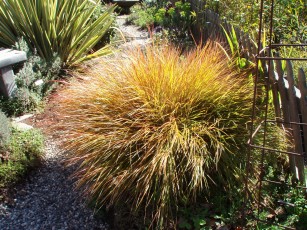
As in all gardens there is always a bit of maintenance to keep things looking and working great. Weeding in the first couple of months while plants become established is important. Replenish mulch as needed until the plants grow in.
Periodically remove leaves that have landed in your river bed and reposition rocks moved by runoff to keep your dry creek bed working for you when you need it. Also don?t start your dry creek bed too close to the foundation of your home if that area is flat. You can direct the water through a drain pipe connected to a downspout to a lower starting spot in your garden.
So whether you are adding a dry river bed to add interest to your lawn-free landscape or to double as catchment for winter storm runoff, make yours look like it?s always been there.


